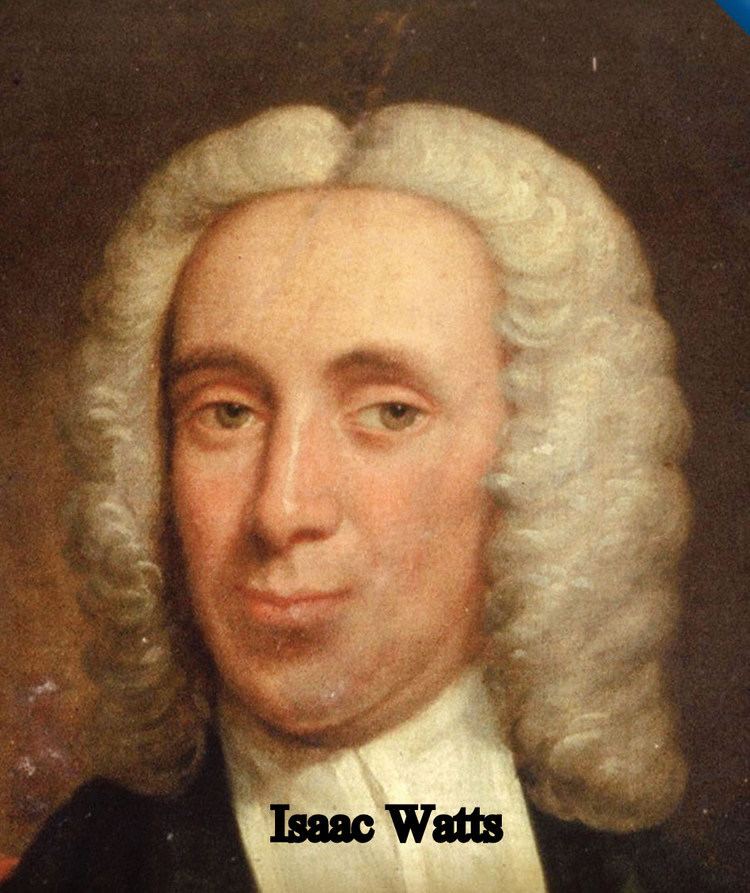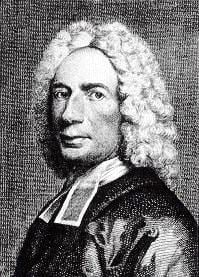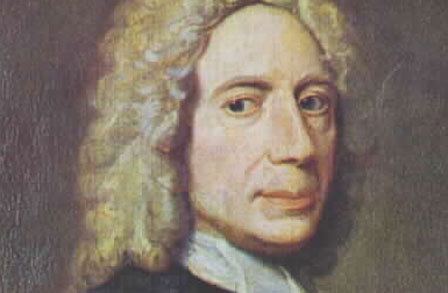Occupation Hymnwriter, theologian Role Writer | Name Isaac Watts | |
 | ||
Known for When I survey the wondrous cross, Joy to the world Books Hymns and Spiritual Songs, The Psalms of David, Divine Songs Attempte, The Improvement of the Mind, Logic - or The right use of rea Similar People Lowell Mason, Charles Wesley, George Frideric Handel, William Croft, Chris Tomlin | ||
101010pm the life and hymns of isaac watts
Isaac Watts (/wɒts/; 17 July 1674 – 25 November 1748) was an English Christian hymnwriter, theologian and logician. A prolific and popular hymn writer, his work was part of evangelization. He was recognized as the "Father of English Hymnody", credited with some 750 hymns. Many of his hymns remain in use today and have been translated into numerous languages.
Contents
- 101010pm the life and hymns of isaac watts
- Isaac watts the fight to expand christian worship
- Life
- Watts and hymnody
- Logic
- Legacy honours and memorials
- Cultural or contemporary influences
- Books
- Hymns
- Quotes
- References
Isaac watts the fight to expand christian worship
Life

Born in Southampton, England, in 1674, Watts was brought up in the home of a committed religious Nonconformist; his father, also Isaac Watts, had been incarcerated twice for his views. At King Edward VI School, Watts had a classical education, learning Latin, Greek and Hebrew.

From an early age, Watts displayed a propensity for rhyme. Once, he responded when asked why he had his eyes open during prayers:
Receiving corporal punishment for this, he cried:

Because he was a Nonconformist, Watts could not attend Oxford or Cambridge, which were each restricted to Anglicans, as were government positions at the time. He went to the Dissenting Academy at Stoke Newington in 1690. Much of the remainder of his life centred around that village, which is now part of Inner London.

Following his education, Watts was called as pastor of a large independent chapel in London, where he helped train preachers, despite his poor health. Isaac Watts held religious opinions that were more non-denominational or ecumenical than was at that time common for a Nonconformist; he had a greater interest in promoting education and scholarship than preaching for any particular sect.
Taking work as a private tutor, Watts lived with the Nonconformist Hartopp family at Fleetwood House, on Church Street in Stoke Newington. Through them he became acquainted with their immediate neighbours, Sir Thomas Abney and Lady Mary.
Invited for a week to Hertfordshire, Watts eventually lived for a total of 36 years in the Abney household, most of the time at Abney House, their second residence. (Lady Mary had inherited the Manor of Stoke Newington in 1701 from her late brother, Thomas Gunston.)
On the death of Sir Thomas Abney in 1722, the widow Lady Mary and her last unmarried daughter, Elizabeth, moved all her household to Abney Hall from Hertfordshire. She invited Watts to continue with their household. He lived at Abney Hall until his death in 1748.
Watts particularly enjoyed the grounds at Abney Park, which Lady Mary planted with two elm walks leading down to an island heronry in the Hackney Brook. Watts often sought inspiration there for the many books and hymns he wrote.
Watts died in Stoke Newington in 1748, and was buried in Bunhill Fields. He left an extensive legacy of hymns, treatises, educational works and essays. His work was influential amongst Nonconformist independents and religious revivalists of the 18th century, such as Philip Doddridge, who dedicated his best-known work to Watts.
Watts and hymnody
Sacred music scholar Stephen Marini (2003) describes the ways in which Watts contributed to English hymnody. Notably, Watts led by including new poetry for "original songs of Christian experience" to be used in worship. The older tradition was based on the poetry of the Bible, notably the Psalms. This had developed from the teachings of the 16th-century Reformation leader John Calvin, who initiated the practice of creating verse translations of the Psalms in the vernacular for congregational singing. Watts' introduction of extra-Biblical poetry opened up a new era of Protestant hymnody as other poets followed in his path.
Watts also introduced a new way of rendering the Psalms in verse for church services. The Psalms were originally written in Biblical Hebrew within Judaism. In early Christendom, they were affirmed in the Biblical canon as part of the Old Testament. Watts proposed that the metrical translations of the Psalms as sung by Protestant Christians should give them a specifically Christian perspective. While he granted that David [to whom authorship of many of the Psalms is traditionally ascribed] was unquestionably a chosen instrument of God, Watts claimed that his religious understanding could not have fully apprehended the truths later revealed through Jesus Christ. The Psalms should therefore be "renovated" as if David had been a Christian, or as Watts put it in the title of his 1719 metrical Psalter, they should be "imitated in the language of the New Testament."
Marini discerns two particular trends in Watts' verses, which he calls "emotional subjectivity" and "doctrinal objectivity". By the former he means that "Watts' voice broke down the distance between poet and singer and invested the text with personal spirituality." As an example of this, he cites "When I Survey the Wondrous Cross". By "doctrinal objectivity," Marini means that Watts verse achieved an "axiomatic quality" that "presented Christian doctrinal content with the explicit confidence that befits affirmations of faith." As examples, Marini cites the hymns "Joy to the World" as well as "From All That Dwell Below the Skies":
Besides writing hymns, Isaac Watts was also a theologian and logician, writing books and essays on these subjects.
Logic
Watts wrote a text book on logic which was particularly popular; its full title was, Logic, or The Right Use of Reason in the Enquiry After Truth With a Variety of Rules to Guard Against Error in the Affairs of Religion and Human Life, as well as in the Sciences. This was first published in 1724, and it was printed in twenty editions.
Watts wrote this work for beginners of logic, and arranged the book methodically. He divided the content of his elementary treatment of logic into four parts: perception, judgement, reasoning, and method, which he treated in this order. Each of these parts is divided into chapters, and some of these chapters are divided into sections. The content of the chapters and sections is subdivided by the following devices: divisions, distributions, notes, observations, directions, rules, illustrations, and remarks. Every contentum of the book comes under one or more of these headings, and this methodical arrangement serves to make the exposition clear.
In Watts' Logic, there are notable departures from other works of the time, and some notable innovations. The influence of British empiricism may be seen, especially that of contemporary philosopher and empiricist John Locke. Logic includes several references to Locke and his Essay Concerning Human Understanding, in which he espoused his empiricist views. Watts was careful to distinguish between judgements and propositions, unlike some other logic authors. According to Watts, judgement is "to compare... ideas together, and to join them by affirmation, or disjoin then by negation, according as we find them to agree or disagree". He continues, "when mere ideas are joined in the mind without words, it is rather called a judgement; but when clothed with words it is called a proposition". Watts' Logic follows the scholastic tradition and divides propositions into universal affirmative, universal negative, particular affirmative, and particular negative.
In the third part, Watts discusses reasoning and argumentation, with particular emphasis on the theory of syllogism. This was considered a centrally important part of classical logic. According to Watts, and in keeping with logicians of his day, Watts defined logic as an art (see liberal arts), as opposed to a science. Throughout Logic, Watts revealed his high conception of logic by stressing the practical side of logic, rather than the speculative side. According to Watts, as a practical art, logic can be really useful in any inquiry, whether it is an inquiry in the arts, or inquiry in the sciences, or inquiry of an ethical kind. Watts' emphasis on logic as a practical art distinguishes his book from others.
By stressing a practical and non-formal part of logic, Watts gave rules and directions for any kind of inquiry, including the inquiries of science and the inquiries of philosophy. These rules of inquiry were given in addition to the formal content of classical logic common to text books on logic from that time. Watts' conception of logic as being divided into its practical part and its speculative part marks a departure from the conception of logic of most other authors. His conception of logic is more akin to that of the later, nineteenth-century logician, C.S. Peirce.
Isaac Watts' Logic became the standard text on logic at Oxford, Cambridge, Harvard and Yale, being used at Oxford for well over 100 years. C.S. Peirce, the great nineteenth-century logician, wrote favorably of Watts' Logic. When preparing his own text book, entitled A Critick of Arguments: How to Reason (also known as the Grand Logic), Peirce wrote, 'I shall suppose the reader to be acquainted with what is contained in Dr Watts' Logick, a book... far superior to the treatises now used in colleges, being the production of a man distinguished for good sense.'
Watts followed the Logic in 1741 by a supplement, The Improvement of the Mind. This also went through numerous editions and later inspired Michael Faraday. It was also widely used as a moral textbook in schools.
Legacy, honours and memorials
On his death, Isaac Watts' papers were given to Yale University in the Colony of Connecticut, which Nonconformists had established. King Edward VI School, which he attended, named one of its houses "Watts" in his honour.
The Church of England and Lutheran Church remember Watts (and his priestly service) annually in the Calendar of Saints on November 25, and the Episcopal Church on the following day.
The earliest surviving built memorial to Isaac Watts is at Westminster Abbey; this was completed shortly after his death. His much-visited chest tomb at Bunhill Fields, dates from 1808, replacing the original that had been paid for and erected by Lady Mary Abney and the Hartopp family. A stone bust of Watts is installed at the Nonconformist Dr Williams's Library, in central London. The earliest public statue, erected in 1845, stands at Abney Park, where Watts had lived for more than 30 years at the manor house, where he also died. The park was later devoted to uses as a cemetery and public arboretum. A later, rather similar statue was funded by public subscription and erected in a new Victorian public park named for Watts in Southampton, the city of his birth. In the mid-nineteenth century, the Congregational Dr Watts Memorial Hall was built in Southampton and named for him. After World War II, it was lost to redevelopment. The Isaac Watts Memorial United Reformed Church was built on the site and named for him. One of the earliest built memorials may also now be lost: a bust to Watts that was commissioned on his death for the London chapel with which he was associated. The chapel was demolished in the late 18th century; remaining parts of the memorial were rescued at the last minute by a wealthy landowner for installation in his chapel near Liverpool. It is unclear whether the bust survives. The stone statue in front of the Abney Park Chapel at Dr Watts' Walk, Abney Park Cemetery, was erected in 1845 by public subscription. It was designed by the leading British sculptor, Edward Hodges Baily RA FRS. A scheme for a commemorative statue on this spot had first been promoted in the late 1830s by George Collison, who in 1840 published an engraving as the frontispiece of his book about cemetery design in Europe and America; and at Abney Park Cemetery in particular. This first cenotaph proposal was never commissioned, and Baily's later design was adopted in 1845. In 1974, the City of Southampton (Watts' home city) commemorated the 300 year anniversary of his birth by commissioning the biography Isaac Watts Remembered, written by David G. Fountain, who like Watts, was also a non-conformist minister from Southampton.
Cultural or contemporary influences
One of Watts' best-known poems was an exhortation "Against Idleness and Mischief" in Divine Songs for Children. This was parodied by Lewis Carroll in the poem "How Doth the Little Crocodile", included in his book Alice's Adventures in Wonderland. His parody is better known than the original Watts' poem.
In his novel, David Copperfield (1850), Charles Dickens has school master Dr. Strong quote from Watts' "Against Idleness and Mischief".
The 1884 comic opera Princess Ida includes a punning reference to Watts in Act I. At Princess Ida's women's university, no males are allowed. Her father King Gama says that "She'll scarcely suffer Dr. Watts' 'hymns'".
Books
Hymns
Watts' hymns include:
Many of Watts' hymns are included in the Christadelphian hymnal, the Evangelical Lutheran Worship Hymnal, the Baptist Hymnal, the Presbyterian Trinity Hymnal, and the Methodist Hymns and Psalms. Many of his texts are also used in the American hymnal, The Sacred Harp, using what is known as the shape note notation used for teaching non-musicians. Several of his hymns are used in the hymnals of the Church of Christ, Scientist and The Church of Jesus Christ of Latter-day Saints.
Quotes
Learning to trust is one of life's most difficult tasks
For Satan finds some mischief still For idle hands to do
The tulip and the butterfly Appear in gayer coats than I: Let me be dressed fine as I will - Flies - worms - and flowers exceed me still
